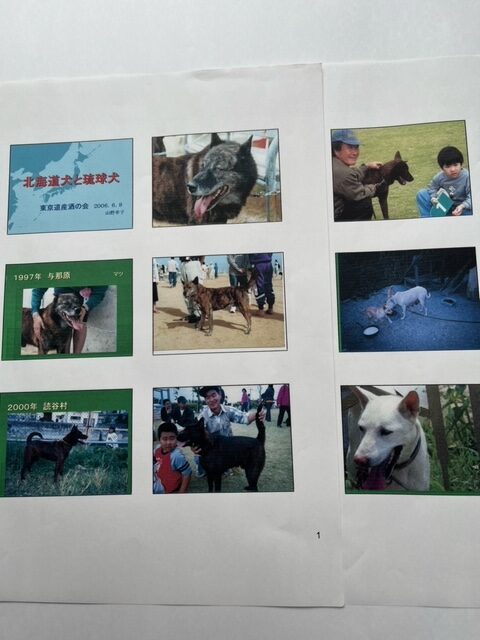琉球犬保存運動と故・新垣義雄先生
比類ない貢献者
1990年、琉球犬保存会を設立し、95年に沖縄県の天然記念物の指定を受けるまでに琉球犬の原型を定着させ、さらに理論と実践において、琉球犬の保存に尽力された新垣義雄先生がご逝去されていたことを昨日、はっきりと知らされた。新垣先生とともに琉球犬のブログ運営や琉球犬の飼育など保存活動をされていた方がブログで書いておられたので間違いなかった。ここ2年間、なんどか新垣先生のご自宅や携帯に連絡をとろうと試みたのだが、連絡がつかず気がかかりだった。
沖縄県庁や琉球新報にも問い合わせをしたが、調べてくださって、丁寧な回答はいただいたが、いずれも「わからない」ということだった。新垣先生は沖縄県庁のOBであり、新聞社も何度も取材した琉球犬保存の恩人であり、琉球犬保存会の初代会長としてもリーダーシップをとられてきたというのに、わからないとはどういうことなのだろう。超ご多忙な新垣先生のことだから、連絡は簡単にはとれない、しかし、新垣先生は、「生きた文化遺産 琉球犬ブログ」を運営されていたのでいつでも連絡はとれると、私も心の片隅では楽観視していた。
そして、昨日、検索を様々試みると、もしやと私が恐れていた新垣会長は他界されたという一文を発見した。「新垣先生は2019年8月に79歳で亡くなられましたが・・・」と「やっちゃん」という筆者によってAmeba ブログに記述されていた。
このブログを読むと、亡くなられる直近までの新垣先生の、琉球犬への変わらぬ愛情と熱意が伝わってくる。新垣先生がおっしゃっていたことが、このブログの筆者によって正確に受け継がれていることがわかり、私の目の前に新垣先生の姿が浮かんでくる。この方のブログは、私が知る限りにおいても新垣先生の理論と実践の足跡を忠実に伝えているからだ。同時にほれぼれする精悍な琉球犬の写真の数々が掲載されている。
琉球犬の展覧会
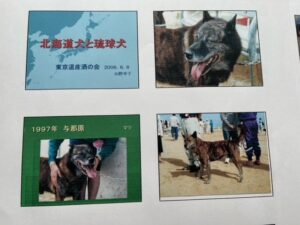
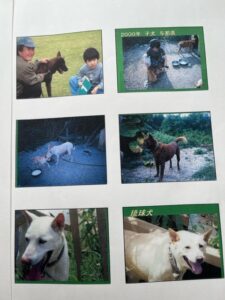
新垣先生は、獣医であり、沖縄県庁で動物愛護センターの所長を務められ、県庁退職後は所長在任中に開始された琉球犬の保存に生涯を捧げられた。
私が新垣先生に初めてお会いしたのは1997年、沖縄読谷村での琉球犬の展覧会だった。展覧会の前日と当日に、新垣先生は北海道から展覧会に来た私に何時間も割いて琉球犬の保存の道のりをお話ししてくださった。
読谷村での展覧会は、家族づれも多く、ピクニックのように、犬も人も交流し合う楽しい会だった。上の写真の虎毛の2頭、マツの写真が2枚と、右下はトラである。当時の琉球犬を代表する2頭だった。
マツには濃い舌斑(舌にある黒い斑点)があって、北海道犬と同様、琉球犬の特色のひとつである。
1年後、私は与那原の新垣先生のお宅を訪問することになり、新垣夫人のアヒルの薬膳料理をいただきながら、琉球犬と北海道犬の話を続けた。
そこで私がお聞きした琉球犬の原型(琉球犬では"標準型“ではなく、原型と使っているようだ)をどのように科学的に試行錯誤をしながら定着させたか。さらに琉球犬は1995年に沖縄県の天然記念物の指定を受けたが、まだ国の指定は受けていない。沖縄のチャンプルー文化、中国、朝鮮半島や東南アジアとの交流が琉球犬にも影響を与え、まさに多文化共生は、従来の日本犬の標準型に統合できないのは当然だ。では沖縄の歴史と社会を背景に、どのように琉球犬の原型を定着させようとしているのか。新垣先生は、その理論と実践について公開されているだけでも驚くほど膨大な記録を残しておられる。新垣先生と、新垣先生が議論を重ねられた岐阜大学、後に麻布大学の田名部雄一教授(琉球犬保存会顧問)の論文等に基づいて、「琉球犬が生きた文化遺産」と言われる理由の私の理解を次の章で述べたい。
(注)上掲の写真は2枚を除いて筆者が、展覧会場と、新垣会長のご自宅で撮った。右下の2頭の白の琉球犬の写真2枚は新垣会長からいただいた。白い琉球犬の繁殖が成功して間もない頃だった。
琉球犬の原型と系統
「生きた文化遺産」は新垣先生が琉球犬に好んで使われたが、北海道犬にも他の日本在来犬に対しても適切な表現だと思う。
琉球犬と北海道犬は、1991年の日本の在来犬を含む犬種の遺伝子構成の調査(岐阜大学・麻布大学の田名部雄一教授)によって、もっとも近い遺伝子構成であると実証された。
琉球犬保存会は、田名部雄一教授を顧問に迎えて、新垣先生を中心に現存の原型を具える琉球犬を繁殖することに注力されていた。外観で言えば虎毛、胡麻、赤、白など北海道犬と同じタイプの犬もいたが、短毛で濃い赤(あるいは鮮やかな赤)に、金色の目の犬は、日本の在来犬では初めて見た。
新垣先生は沖縄県庁を退職される直前は、県の動物愛護センターの所長をされていた。1980年代の末から90年代、センターに収容される多数の野犬や迷い犬の中にあきらかに、沖縄の在住犬のトゥラー (虎 → 虎毛)やアカイン(赤犬)がいた。新垣所長のところにこのままでは沖縄の犬が絶滅すると心配や助言、処分することへの苦情があったことがきっかけで、新垣所長も本気で保存について行動に移し始めた。県庁退職後に琉球犬保存会を設立し、狩猟で在来犬を使った狩猟が盛んだった、沖縄本島北部の山原(ヤンバル)や台湾に近い八重山列島まで視野に入れて保存活動を開始されて95年には沖縄県の天然記念物の指定を受けた。
新垣先生は、グレートデンやシェパードだと思われる西洋犬の写真を数枚取り出して、「皮肉なことに、「金網で囲われた米軍基地の中に、琉球犬の遺伝子を持つミックス犬が散見されているんですよ。これらの犬は西洋犬と琉球犬の混血で、外観はグレートデンやシェパードであっても、囲われた基地の中だけで飼われてきたので、基地の敷地内で琉球在来犬と繁殖した血統が維持されている」と言われた。そこで、田名部先生の指導を得て、獣医の新垣先生が琉球犬保存会の会員仲間と協力して、基地内の琉球犬の遺伝子を持つ犬も排除しないで、沖縄に生息する琉球犬の遺伝子情報を復元していくことに取り組んでいるという。人間の一生と比べれば、犬のドッグイヤーと言われる年数は短く、新垣先生は、自分が生きている間にどのくらい実現できるか、今、琉球犬保存会には若い仲間がいるので心強いとおっしゃっていた。
北海道犬も、北海道の歴史と社会背景との密接な関わりの中で適合させて様々な方々の貢献があった。琉球犬の場合も、元来、人間には従順で穏やかな琉球犬を、都市のなかでもペットとして、人間社会と共存する琉球犬を保存することに、新垣先生を筆頭に琉球犬保存会の方々は全力を挙げておられた。沖縄の地元の犬を日本在来の犬として保存していくためには、他の日本犬と同様に、琉球犬が国の天然記念物として指定され、その保存に関わる琉球犬保存会が他の日本犬の保存団体と同様に、国から資金面はじめ便宜供与を受けないと、保存はますます困難になる。もっとも文化庁が補助してくれるのは有難いことではあるが、資金面の援助と言っても会の規模によるのだろうが、ごくわずかで期待できる額ではない。会は独自で会員を増やし、会員収入や寄付で運営している。とりわけ、会長や一部の人々の負担に負っているところが多いと見受ける。新垣先生のご苦労は並大抵ではなかったことは、周囲の方々が一番ご存じだったと思う。
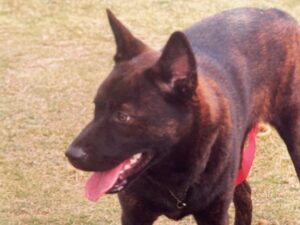
1998年 沖縄県読谷村での琉球犬保存会(新垣義雄会長)主催の琉球犬展覧会
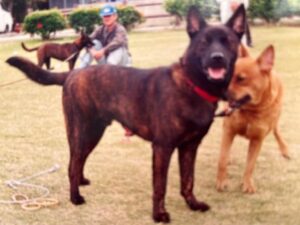
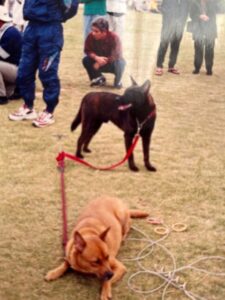

琉球犬の保存を次世代にも期待
琉球犬の系統としては、沖縄本島北部の山原(ヤンバル)系統と、八重山系統はあきらかに区分できるようだった。これらについては新垣先生も書き物やブログ、取材などで特色をお話しされている。ヤンバルの森で、イノシシ猟をしてきた琉球犬と、かつて中国への朝貢のための馬産地であった八重山で、馬に騎乗して行う猟に使われた琉球犬とでは、サイズや特徴が異なるという仮説を持っておられると言われた。私は新垣先生とは2009年ごろまでは実際にお会いしてお話する機会があったが、その後2010年からの10年間は、私も仕事の都合で新垣先生とはお電話でもお話する時間がなくなってしまった。新垣先生が休む時間がないことはいつものことだった。この間にどのように新垣先生の理論と実践が進化されたのか、新垣先生とブログを一緒に運営されたと思われる、私がたまたま読んだAbema ブログの「やっちゃん」に教えてもらいたいと思う。この方は、琉球犬保存会の趣旨を理解されて、新垣先生と一緒に活動されたきた方だと私にはわかる。
故・新垣先生は、今は一時的に閉鎖されているようだが、すべてをご自分のブログ「生きた文化遺産”琉球犬”ブログに残しておられる。そのなかには犬の専門誌やメディアで取材された内容の概略の記録もある。琉球犬保存会の現在は、どうなっているかはわからないが、少なくとも様々な人々が、琉球犬についての学べる環境を新垣先生はつくられたことは間違いない。
2010年以降、新垣先生は、東南アジアから沖縄への人と物流、人と犬の往来から、沖縄独特の交流による日本犬の原型を模索されていた。北海道犬も日本の本州からの流れを汲む北海道犬だけでなく、東西からの北方の人々、物流や犬の往来によって、北海道犬の系統を区分して整理した。また日高山地のような厳しい自然環境によって隔離された地域では、その地域の犬をひとつの系統として区分した。時代とともにそれらの系統は混雑され、やがて姿を消していった。歴史上、社会の進展上どんなに貴重で残したい犬の原型であっても、今の時代の人々が愛好して飼ってくれないと犬は姿を消してしまうのだ。
ただし、姿を消してしまう前に、これまでの沖縄の犬たちがどのような役目と存在だったかを一度は理解してもらいたいと、新垣先生は実践され、記録され、発信されたのだった。その記録は生きているので、混乱や活動休止があったとしても、琉球犬は人々に飼育され愛され続けることを確信している。それほど琉球犬の保存活動の実証と記録は貴重な活力になっていくと考えるからだ。
(了)
Ryukyu Dog Preservation Movement / the Late Dr. Yoshio Arakaki:
Irreplaceable contributor to the preservation of Ryukyu dogs
Yesterday, I learned that Dr. Yoshio Arakaki, who established the Ryukyu Dog Preservation Society in 1990, settled the prototype of the Ryukyu dog until it was designated a natural treasure of Okinawa Prefecture in 1995, and further devoted himself to the preservation of the Ryukyu dog in theory and practice, had passed away. I was made aware of this because the person who had been involved in preservation activities, such as running the Ryukyu dog blog and breeding Ryukyu dog together with Dr. Arakaki had written about it on her blog.
Prior to this, I had tried to contact Dr. Arakaki at his home and mobile phone several times over the past two years but I could not reach him, and it got me worried about him and his family. I had also contacted the Okinawa Prefectural Government and the Ryukyu Newspaper(琉球新報). They looked into the matter, but they all said that they did not know. Dr. Arakaki formerly served for the Okinawa Prefectural Government, contributed to the preservation of Ryukyu dogs, and was interviewed by the newspaper many times. Additionally, he was the first chairman of the Ryukyu Dog Preservation Society, so I wondered what they meant that they did not know about his whereabouts. Before his passing, Dr. Arakaki was always a very busy man, so it was not easy to get in touch with him. However, in a corner of my mind, I was optimistic that I could contact him any time since he was running the “Living Cultural Heritage: Ryukyu Dog Blog”.
Then, yesterday, after various attempts to search, I found a sentence, which I had feared for. The sentence read that Chairman Arakaki had passed away. It was written on the Ameba blog by an author named “Yachan” that “Dr. Arakaki passed away in August 2019 at the age of 79…”
Reading this blog, I can feel Dr. Arakaki’s unchanging love and passion for Ryukyu dogs right up to the time of his passing. I could see that Dr. Arakaki’s studies have been accurately passed on to the author of this blog and in my mind, I could recollect Dr. Arakaki’s sayings. This is because Yachan’s blog, as far as I know, faithfully carries on the footsteps of Dr. Arakaki’s theory and practice. At the same time, it contains a number of photos of the admirable and intrepid Ryukyu dogs.
Ryukyu dog exhibition (Matsu and Tora)

 Dr. Arakaki was a veterinarian and director of the Animal Protection Center at the Okinawa Prefectural Government. After retiring from the prefectural government, he devoted his life to the preservation of Ryukyu dogs, which he started during his tenure as director.
Dr. Arakaki was a veterinarian and director of the Animal Protection Center at the Okinawa Prefectural Government. After retiring from the prefectural government, he devoted his life to the preservation of Ryukyu dogs, which he started during his tenure as director.
I first met Dr. Arakaki in 1997 at an exhibition of Ryukyu dogs in Yomitan-son, Okinawa. I came from Hokkaido to attend the exhibition. On the day before and the day of the exhibition, Dr. Arakaki spent hours talking to me about his path to the preservation of Ryukyu dogs.
The exhibition in Yomitan-son was a fun event designed for families as well, and it was like a picnic, with both dogs and people interacting with each other. The two tiger-haired dogs in the photo above are two photos of Matsu, and a photo of Tora in the lower right. These two dogs represented the Ryukyu dogs of the time.
Matsu has a dark tongue mark (black spots on the tongue) like some Hokkaido dogs, which is one of the characteristics of Ryukyu dogs, but not always found.
A year later, I was invited to visit Dr. Arakaki’s home in Yonabaru, where we continued our conversation about Ryukyu dogs and Hokkaido dogs over dinner, enjoying Mrs. Arakaki’s duck herbal cuisine.
I asked him how he established the prototype of Ryukyu dog (Ryukyu dog seems to use the term “prototype” rather than “standard “) through scientific trial. Furthermore, Ryukyu dogs were designated as a natural treasure of Okinawa Prefecture in 1995 but have not yet been designated as a national treasure of Japan. Okinawa’s Chanpuru culture and interactions with China, the Korean Peninsula and Southeast Asia have influenced the Ryukyu dog, and as such, this very multicultural symbiosis cannot be treated the same as the conventional standard type of Japanese dog.
I wondered how then, against the complex background of Okinawan history and society, he is trying to establish the prototype of Ryukyu dog. Dr. Arakaki has kept an astonishingly large number of records of his theory and practice and made a large portion of it publicly available. In the following chapter, I would like to explain my understanding of why Ryukyu dogs are called a living cultural heritage, based on papers by Dr. Arakaki and Professor Yuichi Tanabe (advisor to the Ryukyu Dog Preservation Society) of Gifu University and later Azabu University, with whom Dr. Arakaki had many discussions.
*Note: All but two of the photos above were taken at the exhibition and at the home of Chairman Arakaki by the author. The two photos of the white Ryukyu dogs in the lower right were given to me by Chairman Arakaki. It was just after the successful breeding of white Ryukyu dogs.
Ryukyu dog Prototypes and Lineages
Although “living cultural heritage” was Dr. Arakaki’s preferred term for Ryukyu dogs, I believe it is also appropriate for Hokkaido dogs and other native Japanese dogs.
A 1991 study of the gene structure of dog breeds, including native Japanese dogs (by Professor Yuichi Tanabe of Gifu University / Azabu University) demonstrated that the Ryukyu and Hokkaido Dogs have the closest gene structures.
The Ryukyu Dog Preservation Society, with Professor Yuichi Tanabe as its advisor, and Dr. Arakaki as its leader, focused its efforts on breeding Ryukyu dogs that would be the original type of dogs in existence. In terms of appearance, there were dogs of the same type as Hokkaido dogs with their tiger-haired, sesame, red, light red (or beige), and white colors, but I had never seen a dog native to Japan that has short hair, dark red (or bright red), with golden eyes.
Dr. Arakaki was the director of the Okinawa Prefectural Animal Protection Center just before he retired from the Okinawa Prefectural Government, and in the late 1980s and 1990s, among the many stray and wild dogs brought into the center, there were obviously Okinawan native dogs, also known as Ryukyu dogs, such as Tura (tiger → tiger coat) and Akayin (red dog). As the director of the Center, Dr. Arakaki began to take actions seriously to preserve these dogs when he received concerns, advice, and complaints that the dogs in Okinawa would become extinct if the situation continued as it was. After retirement, he established the Ryukyu Dog Preservation Society and began preservation activities with an eye to the Yambaru Islands in the northern part of the main island of Okinawa and the Yaeyama Archipelago near Taiwan, where hunting with native dogs was popular, and in 1995 the dogs were designated as natural treasure of the Okinawa Prefecture.
Dr. Arakaki pulled out several photos of Western dogs that appeared to be Great Danes or Shepherds and said, “Ironically, there are mixed dogs with genes of Ryukyu dog scattered throughout the U.S. military base. These dogs are a mixture of Western and Ryukyu dogs, and even though they may look like Great Danes or Shepherds, they have been kept only inside the enclosed base, so they maintain a bloodline bred with Ryukyu native dogs on the base grounds.” So, with the guidance of Dr. Tanabe, Dr. Arakaki worked with fellow members of the Ryukyu Dog Preservation Society to restore the genetic information of Ryukyu dogs in Okinawa, without excluding the dogs that also have Ryukyu dog genes on the base. As the lifetime of dogs is much shorter than that of humans, together with the young friends he had in the Ryukyu Dog Preservation Society, Dr. Arakaki said that he was encouraged to see how much he could research and achieve during his lifetime. The preservation movement of Hokkaido dog also had contributions from various people with the history and modernization of Hokkaido in mind in order to preserve both traditional hunting dogs as well as socialized pets.
In the case of Ryukyu dogs, Dr. Arakaki and others in the Ryukyu Dog Preservation Society did their utmost to preserve Ryukyu dogs as pets even in urban areas, which were obedient and gentle to humans to begin with. In order to preserve the local dogs of Okinawa as native Japanese dogs, it will become increasingly difficult unless Ryukyu dogs, like other Japanese dogs, are designated as a natural monument of Japan and the Ryukyu Dog Preservation Society, which is involved in their preservation, receives financial and other support from the government, as other Japanese dog preservation groups do. In the case of Hokkaido Dog Preservation Society, despite being designated as the official organization, the Agency for Cultural Affairs is subsidizing small amount of financial support depending on the size of the association. Which is why many associations are growing their membership on their own and operates on membership income and donations. As such, associations that have not been officially designated by the state are burdened even further and thus, Dr. Arakaki’s efforts were highlighted once more as extraordinary accomplishments, and those around him knew best.

1998 Ryukyu Dog Exhibition by the Ryukyu Dog Preservation Society (Chairman, Dr. Yoshio Arakaki ),at Yomitanson Okinawa pref.



Expectations for the Next Generation
As for the Ryukyu dog lineage, the Yanbaru (山原)lineage in the northern part of Okinawa Island and the Yaeyama (八重山)lineage seem to be clearly distinguishable. I feel it’s needless to go into details as Dr. Arakaki has explained about the characteristics of these two strains in his writings, on his blog, and in interviews. He told me that he has a hypothesis that Ryukyu dogs used to hunt wild boars in the forests of Yambaru are different in size and characteristics from those used for horseback hunting in Yaeyama, which used to be a horse-producing area for tribute to China. I had the opportunity to meet with Dr. Arakaki in person until around 2009, but subsequently in the 10 years since 2010, I couldn’t get in touch with him even by phone due to my work schedule. Additionally, it was always the case that Dr. Arakaki never had time to rest. I’ve always wanted to learn how Dr. Arakaki’s theory and practice evolved during this 10-year gap period from “Yachan,” an Ameba blogger I happened to read, who appears to have run the blog with Dr. Arakaki. I know that this person understands the purpose of the Ryukyu Dog Preservation Society and has been working with Dr. Arakaki.
The late Dr. Arakaki’s blog seems to be temporarily closed but he left his study and research on his blog, “Ryukyu Dogs, a Living Cultural Heritage”. Among which, there is also a brief record of the contents of his interviews with dog magazines and media outlets. I do not know what the current status of the Ryukyu Dog Preservation Society is, but I am sure that Dr. Arakaki has created an environment where various people can learn about Ryukyu dogs.
Since 2010, Dr. Arakaki had been searching for the prototype of the Japanese dog by examining the records of unique exchange of people, goods, and dogs, from Southeast Asia to Okinawa.
In the case of Hokkaido dog, dogs were also classified based on the exchange of people, goods and dogs with regions north, east and west of Hokkaido, as well as the Japanese main island, Honshu. In areas isolated by the harsh natural environment, such as the Hidaka Mountains, the dogs of that area were classified as a single lineage as there was limited interaction with other regions. Over the course of an era, these lineages became intermingled and eventually disappeared. No matter how valuable the original dog figure may have been in history or in the development of society, if people do not need and keep the dog, it will disappear.
However, before the lineage disappears, Dr. Arakaki wanted people to understand the role and existence of the dogs in Okinawa, so he practiced, documented, and disseminated the information. Since the records are still available, I am confident that Ryukyu dogs will continue to be bred and loved by the people, even if there is confusion and suspension of activities. This is because the studies, findings, and record of Ryukyu dog preservation activities are valuable resources to keep up the vitality.
End.
